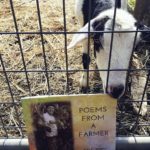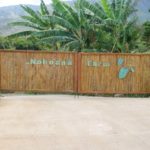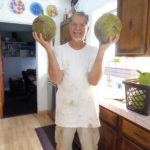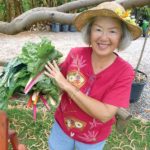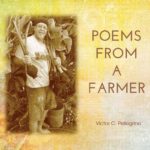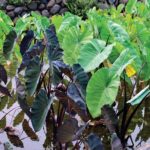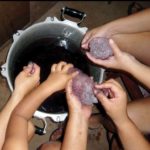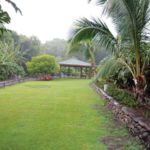Humble words . . . from a scholarly man
Latest gift from UH-MC’s retired English Professor Emeritus Victor Pellegrino
On the first sunny day in what has felt like 40 days and 40 nights of rain on Maui, retired University of Hawai’i Maui College English Professor Emeritus Victor Pellegrino, carefully walks through his many pathways of gardens. For this Italian man, gardening is a way of life. He remembers helping his father pull weeds and work in the soil of his grandfather’s “orto” (Italian for garden) when he was very young, back in Niagara Falls, N.Y.
“During World War II, the president encouraged people to plant ‘Victory Gardens’ — well, we Italians already had our ‘orto,’ ” explains Pellegrino. “It was a natural thing my grandfather and father did. It was natural for me to like gardens, understand them and eat from them.
“One of the largest farmers markets was in Niagara Falls (the Pine Avenue Farmer’s Market), and my mother would regularly go and shop there — she knew the differences between fresh, locally grown products and those brought in from afar by ‘hucksters,’ ” he chuckles.
Victor and his wife, Maui-born and Wailuku-raised Wallette Garcia Pellegrino, met at Marquette University in Wisconsin where they were both graduate students. They have been on Maui since 1967, when he was offered a teaching position at, what was then, Maui Community College. They’ve raised three children (two daughters, Shelley and Angela, and son Hokuao), and Pellegrino notes that he’s always done a bit of small-scale farming in the yard of the Waikapu house he and Wallette built in 1968.
Now, looking over his crops on his family’s kuleana land called Noho’ana (or “a way of life”) Farm, which is adjacent to his family home, he sadly muses that while the rain has helped in some ways by replenishing the ground water and making the island green, so much rain has also drowned a number of seedlings he was trying to start — even his beloved tomatoes are a bit behind in their growth.
This visit to Noho’ana coincides with the release of Pellegrino’s third book of 26 poems entitled, “Poems From a Farmer.” Dedicated to his seven grandchildren — Jonathan Kamehanaokala Merchant, Ryan Ka’imi Merchant, Malia Lien-Fang Kahikina Merchant, Kawaihua Mei Lin Ka’opuiki Pellegrino, Kealiapa’aikeauhou Angelina Julia Ulumealani Pellegrino, Josh Victor Chase and Cassidy Laraine Chase — the book is filled with musings that came to him during time spent in his garden. The verses cover many different topics.
“These poems just come to me. I don’t start out thinking, ‘I’m going to write a poem,’ ” says Pellegrino.
The opening poem,”A Lament For Taste,” illustrates vividly the tasteless supermarket produce most of us know as vegetables — something Pellegrino and his family no longer have to eat. Later in the book, a love letter to the pomodori, or Italian pear-shaped tomato, called “Il Mio Amore Per I Pomodori,” makes the reader giddy discovering his passionate ode to this beloved fruit:
“It is not unnatural/ that I become happy to see you/ gleaming in the early morning light/ that I become excited to be among your verdant rows/ that I become cheerful when I see you flowering in my orto/ that I think of you each night and day/ that I feel a deep-seated joy/ that I know assuredly/ that I love you more than words can say.”
Ever the farmer, Pellegrino tackles weeding in “An Italian Farmer’s Imperative,” where he most honorably wields his hand sickle to remove unwanted plants from his garden so that his beloved pomodori may thrive, as well as in “On Weeding” a simple poem that evokes all he experiences with his senses — “the sun beating down upon my browned neck,” “the sound of water rushing over the ‘ili, (a small land division in Hawaii)” as he slips into a routine of action, which allows his mind to wander and fill “with thoughts/ I would not have thought/ And emptied my mind of thoughts/ I need not have thought.”
Springing out of his gardening on a farm with several lo’i (an irrigated terrace or pond used to grow kalo/taro), many of the poems express his deep love and admiration of kalo. In “Save Me Not” the kalo is bold, rejecting the “help” of scientists driven by money, politics and greed. In “My Love, Kalo,” his voice is one of a lover or admirer, recognizing the comfort kalo gives to those who farm it and eat it. In the piece “On Farming Kalo” he speaks of its life cycle — from planted huli, or kalo shoots, through to the pa’i ‘ai, or hard-pounded but undiluted kalo.
Not surprising for someone who spends so much of his time out of doors, Pellegrino also includes several paeans of the majesty and joys of nature in “Darkness It Is Not”; ”A Woods Walk,” evocative of Henry David Thoreau’s “Walden”; “If I Were a Tree”; and a beautiful ode that describes the misty clouds that roll in and cover Mauna Kahalawai, commonly known as West Maui Mountains.
Other selections touch on the beauty of watching two dragonflies in “Mate Dancing”; he lovingly includes a moving homage to a pet goat, titled “Miss Curious 2011-2017”; and marks his sadness at seeing dry streams and trees cut down in the poems “Weep No More Dry Tears” and “My Sisters and Me.”
Pellegrino’s clear, concise imagery makes plain his love for the land, kalo (taro), ulu (breadfruit) and farming.
This is Pellegrino’s third book of creative writing, but he is more widely known for his “Writer’s Guide” series of writing books widely used in high school and college English classes across the country — “A Writer’s Guide to Using 8 Methods of Transition,” “A Writer’s Guide to Transitional Words and Expressions,” “A Writer’s Guide to Powerful Paragraphs” and “A Writer’s Guide to Perfect Punctuation.”
Pellegrino exudes excitement as he points out his varieties of citrus trees — lemon, lime, navel and blood orange, grapefruit, tangelo, pomelo and tangerine. His herb garden contains fragrant Cuban oregano, basil, lemongrass, parsley, rosemary and sage — there could be the beginnings of a folk song in there.
Sheltering visitors from the sunny skies, while bestowing luscious fruits are coconut, papaya, ulu, banana, star fruit and Surinam cherry trees. The Surinam cherries are very bittersweet and are used in making a delicious jam.
Spreading their strong, proud branches over all are trees of “enlightenment” — the kukui tree — so called because the Hawaiians used to stick the nuts on skewers and would then burn them at night for light. Each nut would take one minute to burn, acting as a clock as well.
Nothing goes to waste on this farm. If a banana is eaten, the peels are tossed on the ground and worked into the soil. Pellegrino has a hardy variety of string beans, which if they don’t get picked in time, no worries — he lets them dry and then harvests the seeds for replanting.
“I had kale, but my goats got loose and ate all the kale,” laughs Pellegrino.
The goats on this farm eat very well, as do the chickens. They get all the edible leftovers that the family cannot eat. The chickens provide delicious eggs to the family; the goats provide love.
“When we have pineapples, we cut the tops off and plant them,” continues Pellegrino, as he points to the healthy pineapple patch next to his herb garden. “We don’t fertilize, except for mulching. We have an organic farm. Everything is done by hand — no chemicals. We follow the farming practices of our kupuna.”
In 2004, Pellegrino acquired the ancient tract of land, or ‘ili, known as Noho’ana, and he and Hokuao set about restoring the lo’i. Hokuao, who works for Kamehameha Schools Maui, connected with his Hawaiian heritage when he was a freshman in college. As his knowledge and understanding of Hawaiian culture deepened, his desire to embrace and perpetuate that culture grew.
Hokuao also discovered a wealth of support from ‘Onipa’a Na Hui Kalo, a statewide organization that supports the revival of kalo farming. When the Pellegrinos were ready to restore their lo’i, more than 125 people — friends, family, neighbors and people from the organization — came from around the state and aided them in clearing the land; rebuilding the kipapa, or stone walls, which held the terraced lo’i in place; and replanting the kalo.
Pellegrino’s ‘ili runs alongside Waikapu stream. For years, the fresh water had been diverted for the production of sugar cane, but with sugar’s demise, and the hard legal work of kalo farmers statewide, the water is running at about 65 percent through Na Wai Eha, or the Four Great Waters — Waikapu, Wailuku, Waiehu and Waihee streams. The increased water has meant Noho’ana Farm has been able to restore several of its lo’i.
Since Pellegrino retired in 1995, he’s able to devote more of his time to helping his son with the farm.
“We want to keep the ‘culture’ in ‘agriculture,’ ” enthuses Pellegrino. “Besides food, we produce knowledge and understanding of Hawaiian culture. We have people come here who want to learn not just about farming, but about the culture.”
In 2006, the Pellegrinos built a pavilion on the farm. It was a place where they could host school children and even college and university students for a day at a real working farm. They originally started with second- and third-graders and older students, then Hokuao suggested they ought to start with preschoolers — the sooner they start teaching, the better.
“When the keiki come here, we ask them questions: ’Who has been on a taro farm?’ ‘What is taro?’ ‘Who has planted taro?’ ”
“It’s surprising how few (have been). When we ask them, ‘Where does your food come from?’ they answer, “The supermarket! My mama goes to the supermarket.”
“After their visit, they understand,” explains Pellegrino.
Noho’ana Farm has hosted more than 13,000 children and adults who came to learn how to plant, harvest and prepare kalo. The visitors’ reward is they get to eat the food and they walk away with a better understanding of Hawaiian culture.
” ‘Ulu and kalo are probably some of the best ‘world’ foods,” notes Pellegrino. “They are a complex carbohydrate, which means the sugar breaks down slowly, versus rice or pasta which breaks down quickly.”
This is important particularly for diabetics who need to avoid those foods that are considered simple carbohydrates and are rapidly digested.
“I’ve made gnocchi with ‘ulu flour; they’re very light,” admits Pellegrino. “It’s been a good thing to have this food in our diet. The average Hawaiian ate four to six pounds of ‘ulu and kalo a day.”
Before Western contact, there were 300 varieties of kalo; there are now 80 varieties left. Noho’ana Farm is growing 44 varieties.
“They taste different,” notes Pellegrino. “There are different colors; one has a smoky flavor and one tastes almost like popcorn.”
“My father’s book is a result of many exciting experiences and challenges on the farm these past 14 years, and he has articulated well our commitment to the environment, to community engagement and to our aloha aina. ‘Poems from a Farmer’ is a perfect extension of our mission at Noho’ana Farm: E ola mau ka mahi’ai ku’una — perpetuating traditional Hawaiian agriculture. Everything we do on our farm is mission driven,” adds Hokuao proudly.
For more information about Noho’ana Farm, any of its products, or to schedule an educational visit, go to www. nohoanafarm.com.
Pellegrino’s next book signing is scheduled during Wailuku First Friday, from 6 to 8:30 p.m. May 4 at Native Intelligence, 1980 Main St.
To purchase copies of “Poems From a Farmer,” visit Hale Ho’ike’ike at the Bailey House Museum, 2375 Main St. or Native Intelligence, both in Wailuku.
To order one to five copies, email italiano@hawaii.rr.com or send a check– $18.95 per book–payable to the author, to Victor Pellegrino, P.O. Box 967, Wailuku, HI 96793. Books will be shipped postage free in the U.S.
* Catherine Kenar can be reached at ckenar@mauinews.com.
- Kalo lo‘i on Noho‘ana Farm — Photo courtesy the author
- Farm goat enjoying a copy of Victor Pellegrino’s latest poetry book. — Photo courtesy the author
- Front gates into Noho‘ana Farm — Photo courtesy the author
- Victor holding ‘ulu, or breadfruit. — Photo courtesy the author
- Wallette Garcia Pellegrino harvesting fresh greens. — Photo courtesy the author
- Front cover of “Poems From a Farmer” — Photo courtesy the author
- A lo‘i at Noho‘ana Farm with several varieties of kalo — Photo courtesy the author
- Students prepare the harvested kalo for lunch. — Photo courtesy the author
- The pavilion where guests learn to prepare and cook kalo and then have lunch. — Photo courtesy the author
- To learn more about the story of how Noho‘ana Farm came to be, read Victor Pellegrino’s picture book, “Uncle Kawaiola’s Dream.” Beautifully illustrated by Linda Rowell Stevens, the book is written for readers at fourth grade level; however, if you have your own children, grandchildren or nieces or nephews, it’s a wonderful story of accomplishing your dreams. It may be purchased at amazon.com. — Photo courtesy the author


